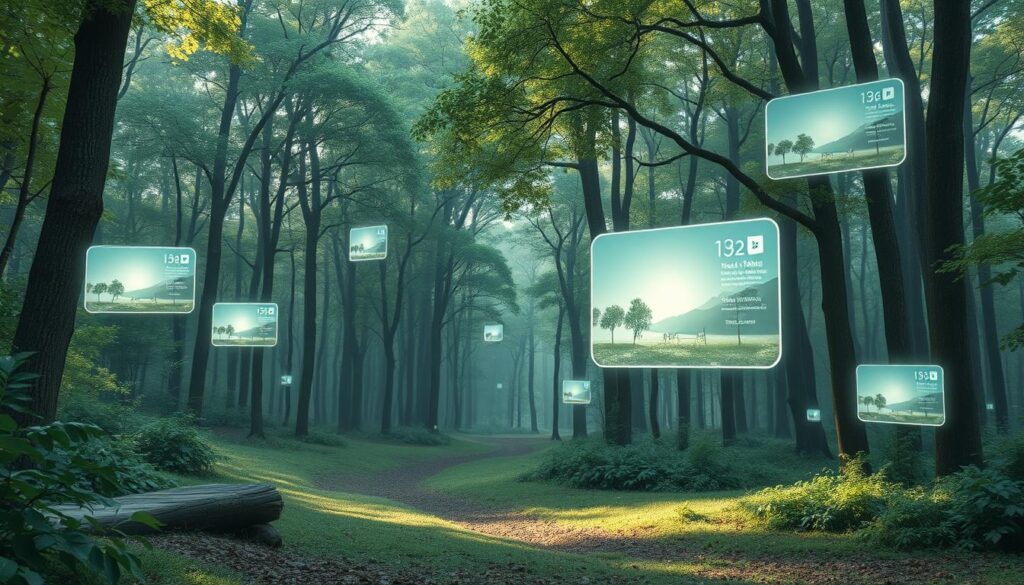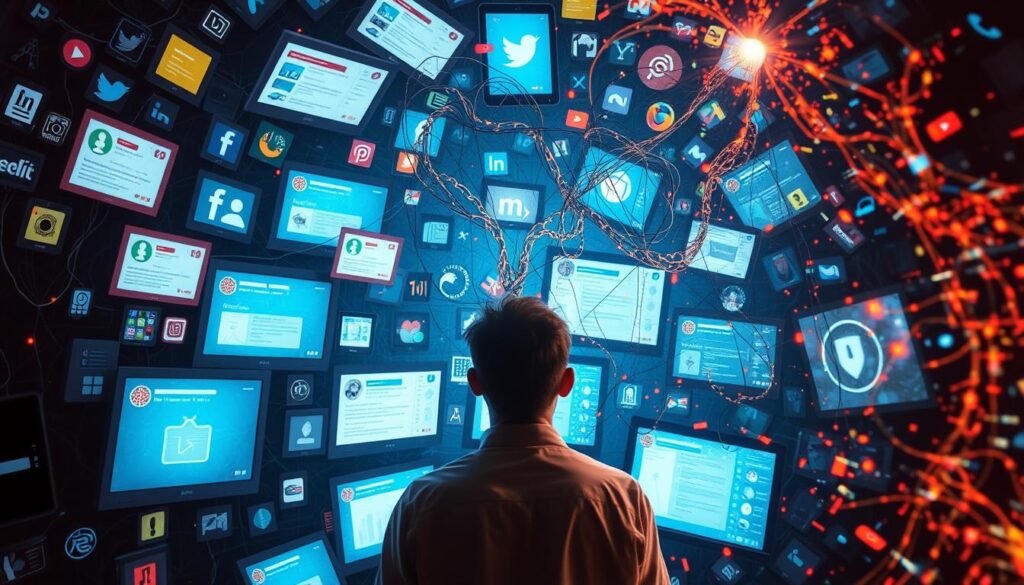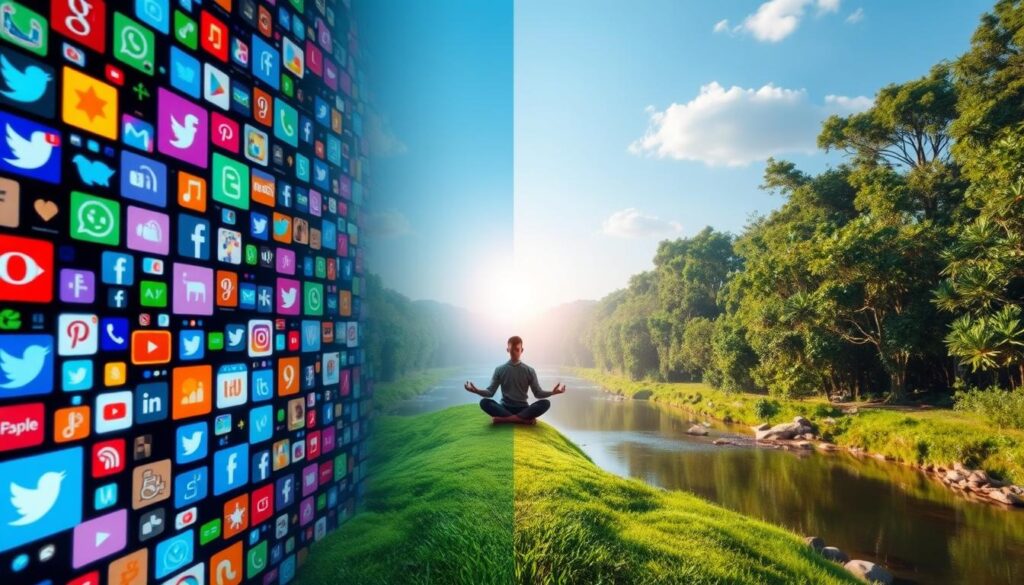Physical Address
304 North Cardinal St.
Dorchester Center, MA 02124
Physical Address
304 North Cardinal St.
Dorchester Center, MA 02124

In today’s world, our digital devices are a big part of our lives. We get bombarded with info, notifications, and the need to stay online. I’ve struggled to find a balance between tech and my mental health. It’s tough to navigate the digital world without losing our emotional and psychological well-being.

The digital age has changed how we live, work, and connect. Technology offers many benefits, but it also harms our mental health. The spread of negativity online and the mix of work and personal life are big problems. It’s time to find ways to take back our digital lives and have a healthier relationship with tech.
We’ll look into digital overload, the social media paradox, and screen addiction. By understanding these issues and finding mindful solutions, we can take control of our digital lives. This way, we can live more harmoniously in the digital age.
In today’s digital world, we face a flood of information and notifications. This is called “digital overload.” It can harm our mental health and well-being. Too much data and constant updates can make us tired, anxious, and less productive.
Digital overload affects us in many ways. Too much screen time and blue light can mess up our sleep. This can hurt our body and mind. The constant digital noise can also make us stressed, confused, and moody.
Seeing perfect lives on social media can make us feel bad about ourselves. It can lead to envy and unhappiness. This can make our mental health problems worse.
To fight digital overload, we need to set boundaries and take breaks. Mindfulness, like meditation, can help us stay calm and focused. Taking care of ourselves and managing digital info can help us find balance.

Dealing with digital overload is a team effort. We need everyone to work together for a better digital world. Employers, policymakers, and tech companies must support mental health. They should help us thrive in the digital age.
Social media connects people worldwide. Yet, it also creates a paradox. It offers connection but can lead to feelings of isolation. Too much time on social media can harm personal relationships and cause mood swings.
The internet’s anonymity can spread negativity and misinformation. It can lead to anxiety, depression, and loneliness, especially in young people. They feel pressured to show a perfect online image, which can be emotionally taxing.
To deal with social media’s downsides, set limits on your use. Use tools to monitor your time online. Replace excessive screen time with activities that bring joy and fulfillment.
Focus on real-life connections and mental health. This helps find a healthy balance with social media. It’s about finding the right amount of online time for your well-being.
Screen addiction is a big problem, hurting personal relationships and reducing face-to-face talks. Teens with mental health issues due to screen addiction are looking for nature-based therapy. ThreePeaks Ascent, a program for teens aged 13 to 17, matches students with therapists who meet their needs.
The “great rewiring” from 2010 to 2015 made screen addiction worse. It changed how kids interact and build relationships. Technology and screen time can affect social skills, confidence, and brain growth in early years.
Effective treatment for screen addiction is holistic. It tackles the behavior and emotional reasons behind excessive screen use. Quitting screens too fast can cause withdrawal symptoms like anxiety and depression, leading to relapse.
To overcome screen addiction, focus on in-person interactions. Create “no-phone” zones and talk about digital limits with family or partners. Reflect on your internet use and set goals for healthy device use. This helps find a balance between digital and real-world connections.
In today’s fast world, it’s key to keep our online and offline lives in check. Social media can make us feel bad about ourselves, leading to comparison and low self-esteem. The fear of missing out (FOMO) and seeking likes can hurt our mental health.
Being always connected can make us stressed and burnt out. It feels like we’re always on call. To fight this, we need strategies for better online health.
Setting clear lines between work and personal life is vital. Taking breaks from digital devices can help us feel better. Mindfulness, like meditation, can also reduce stress from tech use.
Technology can also help our mental health. Online therapy and apps offer support. But, seeing a real person for mental health is best.
Having a healthy digital routine is important. This includes good sleep, exercise, and a relaxing bedtime. By finding a balance, we can enjoy tech without harming our mental health.

In today’s world, finding a balance between tech use and mental health is key. Mindful tech use means being thoughtful about why, how, and when we use digital devices. Simple steps can help us have a healthier relationship with tech and be more digitally mindful.
Try setting times to check your devices instead of constantly. Keep phones and laptops out of your bedroom for better sleep and work-life balance. Apps that track and limit use can also help you understand and control your digital habits.
Being mindful of digital mindfulness and conscious connectivity helps us use tech wisely. It can improve time management, mindfulness, fitness, learning, and social connections. By finding the right balance, we can make tech work for our well-being.
Mindful technology use isn’t about giving up tech. It’s about using it in a balanced and thoughtful way. Being aware of our habits and using simple strategies can help us use tech for our mental health and well-being.
The digital age has changed how we work, making it flexible but also mixing work and personal life. Being always connected through emails and social media can cause burnout and stress. It’s important to set clear boundaries between work and personal time to keep a healthy balance.
Recent studies show that 65% of Americans say work is a big stress factor. Also, 64% say work stress has gone up in the last five years because of constant connection. People now spend almost 6 hours a day on digital devices, making things worse.
Being always available due to digital tech can make people more stressed. Social media can make us feel not good enough, adding to stress and anxiety. The blue light from screens can also mess up our sleep, hurting our mental health.
| Metric | Value |
|---|---|
| Individuals who feel they have a good work-life balance | 21% more likely to be engaged at work |
| Overwork contributions to deaths from stroke and heart disease each year | 745,000 |
| Workers who reported feeling the boundary between work and personal life has become more blurred | 60% |
| Companies with a strong focus on promoting work-life balance | Lower turnover rates and higher levels of employee retention |
To fight the bad effects of digital work on mental health, we need to find ways to balance work and life. This means having device-free times and tech-free weekends. Leaders should also help by cutting down digital distractions, helping people stay focused and well.
By focusing on mental health and creating a balanced digital work culture, companies can help their employees do well. This leads to better well-being, more productivity, and happier jobs.
In today’s digital world, it’s key to balance online and offline connections. Online platforms are great for staying in touch, but nothing beats face-to-face interactions. These real-world connections offer depth and authenticity.
To fight off feelings of loneliness from too much screen time, focus on offline activities. Join local events, clubs, or hobby groups. Also, make time for in-person meetups with friends and family. These actions help you feel part of a community and build strong, meaningful bonds.
When looking for events online, try to be fully present when you attend. Don’t just focus on the digital side. Instead, aim to connect with people on a personal level. This balance helps keep your relationships real and prevents the feeling of isolation that can come with too much digital time.
| Barrier | Impact on Mental Health | Potential Solution |
|---|---|---|
| Lack of digital access | Reduced access to online mental health resources | Affordable internet programs, digital literacy education |
| Limited digital literacy | Difficulty navigating online mental health services | Digital skills training, user-friendly resource design |
| Rural internet challenges | Reduced engagement with online mental health support | Infrastructure investments, telehealth initiatives |
By bridging the digital divide and encouraging real-world connections, we can make sure everyone gets the mental health support they need in today’s digital world.
In today’s world, taking a break from digital devices is crucial. A digital detox means stepping away from screens for a while. It helps people find balance and be more present in their lives.
There are many benefits to a digital detox. It can reduce stress and improve how we interact with others. It also makes us more aware of our surroundings. Studies show many students want to use their phones less, showing a growing need for a break.
Starting a digital detox can change your life. Pick a time, like a weekend, to not use digital devices. Tell your friends you won’t be available, and plan fun activities without screens. This break can improve your mental health and how you feel about technology.
To succeed in a digital detox, clean up your digital space and manage your social media. Set limits on your phone use. This helps you focus better, be more productive, and spend quality time with family and friends.
Going on a digital detox is a journey of self-discovery. With patience and small steps, you can improve your mental health. You’ll also strengthen real-life connections and feel more present every day.
In today’s world, technology has both good and bad sides for our mental health. Too much screen time and social media can lead to anxiety and depression. But, new digital tools are helping a lot with mental health support.
Online therapy platforms and wellness apps are making help easier to get. These tools let people talk to licensed therapists from anywhere. They also offer mood tracking, mindfulness, and self-care plans to help with mental health.
But, remember, tech can’t replace talking to a real person about your mental health. Using online tools with in-person care is the best way. This way, people can use tech to help their mental health while still valuing human connection.
In today’s digital world, getting good sleep is hard. Too much screen time, blue light from devices, and social media can mess with our sleep. To sleep well, we need a regular bedtime, less screen time before bed, and a cozy bedroom.
Studies reveal that 27% of college students say their sleep is poor, and 36% get less than seven hours a night. This lack of sleep can lead to depression, anxiety, and even suicidal thoughts. A study in the Journal of Medical Internet Research found that social media use is linked to more depression and anxiety in adults.
To fight the effects of too much digital time on sleep, experts suggest a few things. Use blue light filters and “night mode” on devices to cut down on blue light in the evening. Try sleep-tracking apps to better your sleep, and make a bedtime routine that helps you relax and avoid screens.
By focusing on digital sleep hygiene, we can protect our mental health in the digital age. Healthy digital habits and a sleep-friendly environment help us get quality sleep. This way, we can use technology wisely and stay balanced.
It’s important to have a balanced digital diet for your mental health. Choose wisely what you see online. Make sure it’s good for you. Spend time each day doing things that don’t involve screens.
Try to focus on one thing at a time with your devices. This helps you concentrate better. Set your phone to “do not disturb” mode when you need to focus. This helps you stay on track and enjoy your time online more.
Teaching people about digital wellness is as important as teaching about exercise and healthy eating. A balanced digital diet helps you avoid the downsides of too much screen time. It also lets you use technology in a way that makes you feel better.